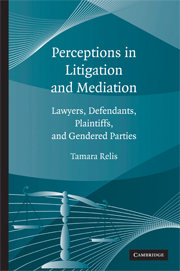Book contents
- Frontmatter
- Contents
- List of tables
- List of figures
- List of abbreviations
- Acknowledgments
- 1 Introduction
- 2 Great misconceptions or disparate perceptions of plaintiffs' litigation aims?
- 3 The voluntary versus mandatory mediation divide
- 4 Consequences of power: Legal actors versus disputants on defendants' attendance at mediation
- 5 Actors' mediation objectives: How lawyers versus parties plan to resolve their cases short of trial
- 6 Perceptions during mediations
- 7 Parallel views on mediators and styles
- 8 Conclusion: The parallel understandings and perceptions in case processing and mediation
- Bibliography
- Index
8 - Conclusion: The parallel understandings and perceptions in case processing and mediation
Published online by Cambridge University Press: 21 August 2009
- Frontmatter
- Contents
- List of tables
- List of figures
- List of abbreviations
- Acknowledgments
- 1 Introduction
- 2 Great misconceptions or disparate perceptions of plaintiffs' litigation aims?
- 3 The voluntary versus mandatory mediation divide
- 4 Consequences of power: Legal actors versus disputants on defendants' attendance at mediation
- 5 Actors' mediation objectives: How lawyers versus parties plan to resolve their cases short of trial
- 6 Perceptions during mediations
- 7 Parallel views on mediators and styles
- 8 Conclusion: The parallel understandings and perceptions in case processing and mediation
- Bibliography
- Index
Summary
“An important measure of a civilization is the quality of justice received by its citizens” (Gold 1991, p. 267). Yet … “procedures of conflict resolution within any state are always being criticized, are always changing and are never as fair and as unbiased as they ideally might be.”
Hampshire (1999, p. 35)Following upon the research question posed in chapter one, “How do professional, lay, and gendered actors understand and experience litigated case processing leading up to and including mediation in legal disputes?,” three recurrent themes have been important throughout the book: (1) the parallel worlds of understanding and meaning prevalent for legal actors versus lay disputants, (2) the reconceptualization of legal actors consequent to involvement with the extralegal dimensions of mediation processes, and (3) the parallel understandings and meanings of gendered actors in both lay and professional groups. In support of these themes, the data and findings throughout the book inform both the empirical-based discourse and the theoretical debates in various literatures.
First, the research has provided empirical data from disputants themselves on how they perceive and address legal disputes and their resolution – offering insight into the little known, yet critical area of litigants' hidden agendas for both formal litigation and mediation processes (Conley and O'Barr 1988, pp. 182–84, 196–97; Guthrie 2001, p. 165) (chapters two and five). Additionally, the findings on the negative transparency effects of mediation add to the scant knowledge on how litigants actually feel during negotiations and what factors affect their perceptions (chapter six) (Relis 2002, p. 175).
- Type
- Chapter
- Information
- Perceptions in Litigation and MediationLawyers, Defendants, Plaintiffs, and Gendered Parties, pp. 226 - 256Publisher: Cambridge University PressPrint publication year: 2009

